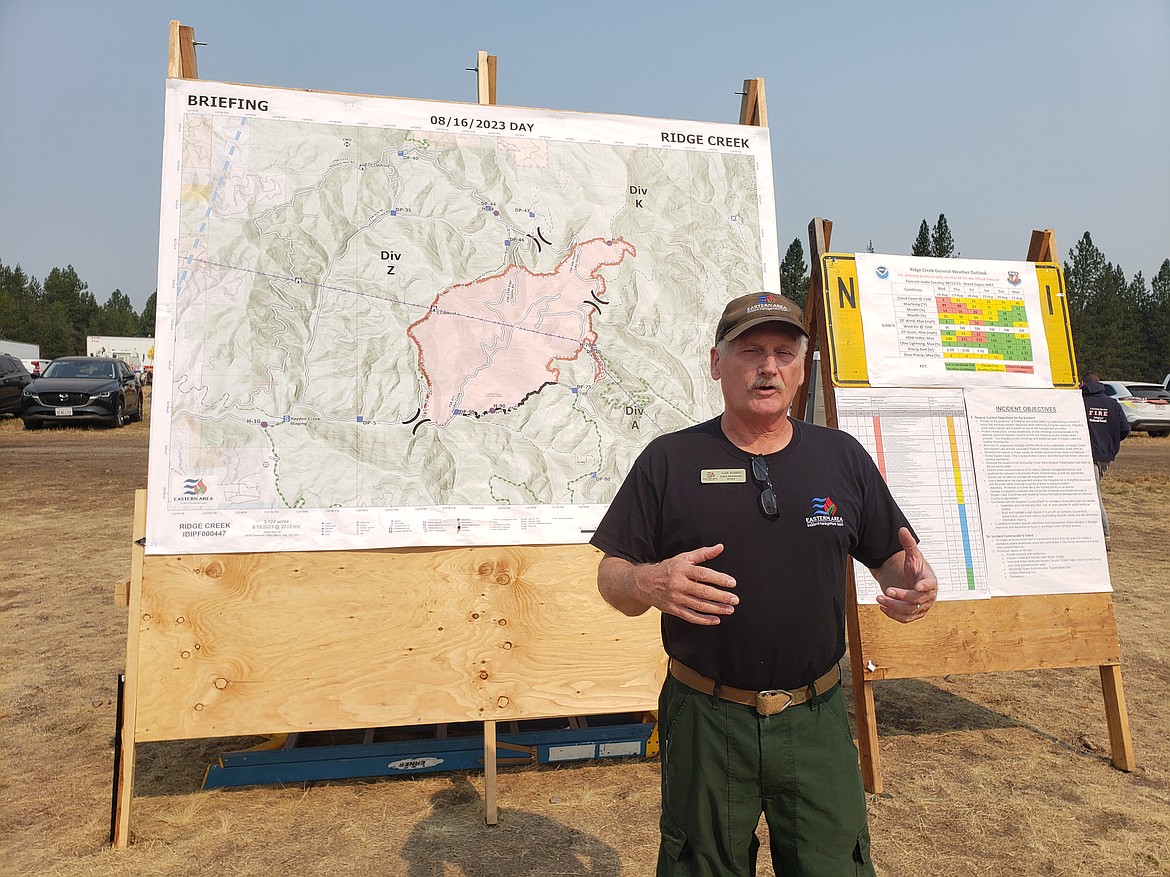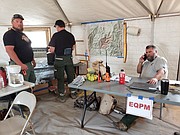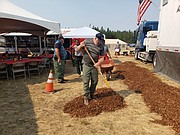A peek inside the fire camp at Ridge Creek
Setting up the Ridge Creek incident command system took a lot of resources.
The fire camp is a small city that houses fire crews and the Eastern Area Incident Management Team, currently 468 people. The camp is built in about 24 hours and it will be taken down in 24 hours, with myriad adjustments in between.
“We’re building new elements of the organization each and every day, and refining things,” Incident Management Team information officer Clark McCreedy said.
Each crew member is fed 5,000 calories per day in three meals catered by Thunder Mountain Catering out of Boise. A mobile shower unit uses 5,000 gallons of potable water per day for hot showers.
The clerical trailer, or “Kinkos on wheels,” holds at least eight printers of various sizes that produce anything from road signs to the “Big Ass Map” used every morning for the 6 a.m. briefing.
The morning briefing is a daily rewrite of the plan of attack for the fire, which the planning team creates overnight.
“The plan gets rewritten everyday,” McCreedy said. “We have a planning meeting at 5 p.m. So our folks come in from the field, deliver the intelligence, form a new plan, and then the planning section goes to work. They produce that new plan and then deliver it to the folks in the morning briefing.”
The fire camp has four major command tents, one for each department, surrounding the BAM and briefing area. Finance, logistics, operations and planning departments each have a chief commander, with a team working 16-hour days for 14 days straight.
The planning department is responsible for daily plans of attack for the fire, maximizing resources to for the greatest impact. The team is made up of specialists including a fire behavior analyst, air quality expert and a meteorologist who make predictions for the operations strategists.
“Finance tracks every dadgum dime, and we’re really accountable for that,” McCreedy said. That includes anything from the cost of spreading bark to keep dust down around the mess hall, to the cost of catering on-site meals.
McCreedy said the logistics department is responsible for getting everything needed from the ground up, including a portable cell phone tower, portable toilets, local excavation equipment, ingredients for meals, shipping, receiving and delivering.
“Feeding a few hundred people a day requires some coordination,” Forest Service public information officer Kelly Miller said.
Portable toilets, or the gray rooms, are cleaned every day. Hand washing is aggressively encouraged at hand washing stations throughout the camp. Hand sanitizers, and foot-pump-operated washing stations are also located near the firefighters' tents and all gray rooms, plus the showers.
The goal is to keep viruses, colds, dirt or grime — camp crud — to a minimum. Cleaning crews are also on staff for daily cleaning and maintenance, so fire crews can focus on fires.
The camp is framed by multiple 50-foot box trucks, refrigerated and standard, with tons of supplies. The refrigerated trucks hold water, Gatorade, snacks and ice, and firefighters fill coolers in the morning from the refrigerated truck to combat the heat on the hill throughout the day.
The other trailers hold bootlaces, shovels, equipment or tools firefighters could need.
Equipment manager trainee Aaron Malson, from Susanville, Calif., will also deliver supplies, like spare tires, hose, pumps or extra shovels, to the front lines as necessary.
“And as soon as humanly possible,” Malson said. “The kind of turnaround is the second I receive the order, I immediately start the dispatch process. And there’s a good chance that within the hour that item is being dispatched.”
Malson also distributes vehicles and ensures that trucks can do what the crews need them to.
“I handle all the rentals that come in,” Malson said. “It’s a crucial part of firefighting. We have to make sure that the vehicles that we’re sending out to the line that people need will not have any breakdowns.”
Command crews and firefighters fly in from across the country bringing tents, their equipment, clothes and toiletries to fight the blaze in Ridge Creek for 14 and up to 21 days.
Everyone sleeps in a small tent for a few hours before going back out to the front lines. Night crews have a quiet location with blackout shades to help them sleep.
Every effort is made to make the space comfortable, McCreedy said, but it’s intense.
The structure of the incident command system follows a national template, so anyone who is called in to work on a fire will integrate seamlessly to the team.
“We have a very deliberate chain of command that no matter where you are in the organization, you know who you answer to,” McCreedy said. “And that’s a critical safety factor in terms of communication.”
The incident crews then work with local agencies to coordinate a structured response.
"The folks that we've dealt with, like Northern Lakes Fire District in particular, I mean they've just been spot on in terms of helping us," McCreedy said.
The Ridge Creek Fire is at 15% containment with over 3,100 acres burned.







